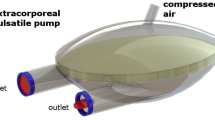Abstract
We report the design and hydrodynamic performance of a pulsatile blood pump and a pneumatic driver system to treat pediatric patients in need of circulatory support while waiting for a heart transplant. The blood pump consists of a pumping chamber with 15 ml stroke volume separated by a flexible diaphragm from a pneumatic chamber. The blood chamber has two orifices fitted with rings in which tri-leaflet tissue valves are placed to control the inflow and outflow of blood. Blood contacting surfaces are heparin coated. The driving unit allows operation of two pumps to assist the left and right side of the heart, independently or simultaneously in three different modes of operation: full-to-empty, ECG synchronized and asynchronous. The flow generated by the pump increases with preload and application of auxiliary negative pressure during the filling phase reaching approximately 1,6 L/min when the pump is operating in full-to-empty mode. The results suggest the performance of the pediatric VAD designed is compatible with the needs of pediatric patients up to 15 kg body weight.
Access this chapter
Tax calculation will be finalised at checkout
Purchases are for personal use only
Similar content being viewed by others
References
Davies, R.R., Russo, M.J., Hong, K.N., et al.: The use of mechanical circulatory support as a bridge to transplantation in pediatric patients: an analysis of the united network for organ sharing database. J. Thorac. Cardiovasc. Surg. 135(2), 421–427 (2008)
Blume, E.D., Naftel, D.C., Bastardi, H.J., et al.: Outcomes of children bridged to heart transplantation with ventricular assist devices. A multi-institutional study. Circulation. 113(19), 2313–2319 (2006)
The July 2012 Extracorporeal Life Support Organization (ELSO) Extracorporeal Life Support (ECLS) Registry Report International Summary. Ann Arbor, Michigan, Extracorporeal Life Support Organization (2012)
Imamura, M., Dossey, A.M., Prodhan, P., et al.: Bridge to cardiac transplant in children: Berlin heart versus extracorporeal membrane oxygenation. Ann. Thorac. Surg. 87(6), 1894–1901 (2009)
Morales, D.L., Almond, C.S., Jaquiss, R.D., et al.: Bridging children of all sizes to cardiac transplantation: the initial multicenter North American experience with the Berlin heart EXCOR ventricular assist device. J. Heart Lung Transp. 30, 1–8 (2011)
Almond, C.S., Morales, D.L., Blackstone, E.H., et al.: Berlin heart EXCOR pediatric ventricular assist device for bridge to heart transplantation in US children. Circulation (127), 1702–119 (2013)
Pantalos, G.M., Ionan, C., et al.: Expanded pediatric cardiovascular simulator for research and training. ASAIO J. 56(1), 67–72 (2010)
Moreira, L.F., Galantier, J., Benício, A., Leirner, A.A., Cestari, I.A., Stolf, N.A.: Left ventricular circulatory support as bridge to heart transplantation in Chagas’ disease cardiomyopathy. Artif. Organs 31(4), 253–258 (2007)
Ferrara, E., Muramatsu, M., Christensen, K.T., Cestari, I.A.: Particle-image velocimetry study of a pediatric ventricular assist device. J. Biomech. Eng. 132(7), 1004 (2010)
Connell, J.A., Khalapyan, T., Myers, J.L., et al.: Anatomic fit assessment for the Penn state pediatric ventricular assist device. ASAIO J. (53), 687–691 (2007)
Wang, S., Caneo, L.F., Jatene, M.B., Jatene, F.B., Cestari, I.A., Kunselman, A.R., Ündar, A.: In vitro evaluation of pediatric hollow‐fiber membrane oxygenators on hemodynamic performance and gaseous microemboli handling: an international multicenter/multidisciplinary approach artif organs 41(9), 865–874 (2017)
Author information
Authors and Affiliations
Corresponding author
Editor information
Editors and Affiliations
Ethics declarations
Research supported by CNPq (National council for Research and Development; Grants 467270/2014-7 and 311191/2017-7) and FAPESP (State of São Paulo Research Foundation Grant 2012/50283-6).
Idágene A. Cestari and the other authors are with the Heart Institute (InCor) of the University of São Paulo Medical School, São Paulo, SP, 05403000, Brazil, (phone: +551126615528; fax: 55 11 26615201; e-mail: cestari@incor.usp.br.
Rights and permissions
Copyright information
© 2019 Springer Nature Singapore Pte Ltd.
About this paper
Cite this paper
Cestari, I.A. et al. (2019). Design and Hydrodynamic Performance of a Pediatric Pulsatile Pump. In: Costa-Felix, R., Machado, J., Alvarenga, A. (eds) XXVI Brazilian Congress on Biomedical Engineering. IFMBE Proceedings, vol 70/1. Springer, Singapore. https://doi.org/10.1007/978-981-13-2119-1_13
Download citation
DOI: https://doi.org/10.1007/978-981-13-2119-1_13
Published:
Publisher Name: Springer, Singapore
Print ISBN: 978-981-13-2118-4
Online ISBN: 978-981-13-2119-1
eBook Packages: EngineeringEngineering (R0)




